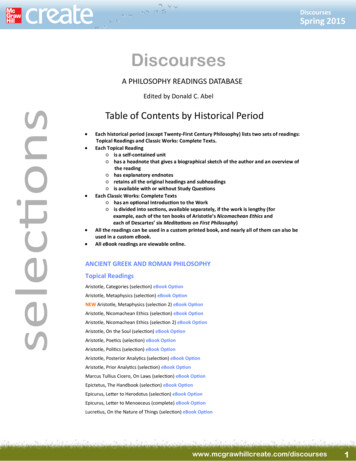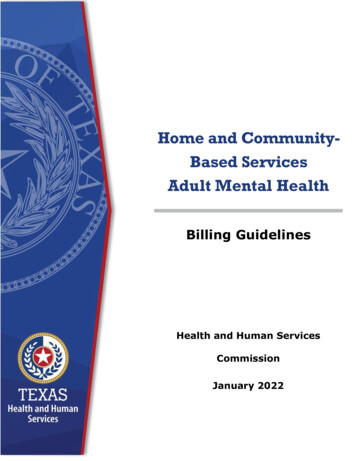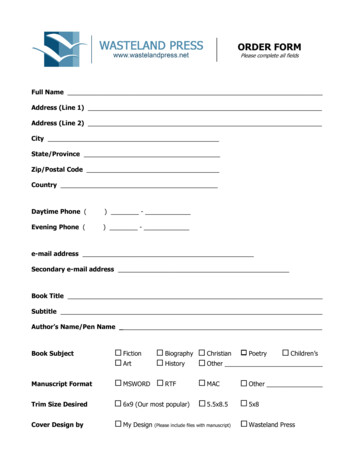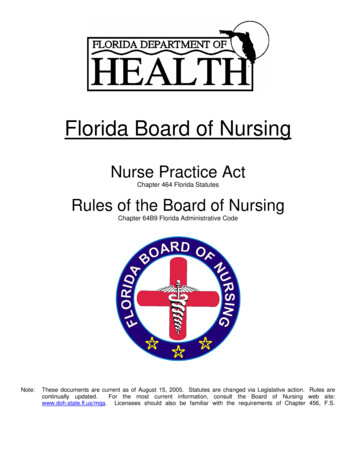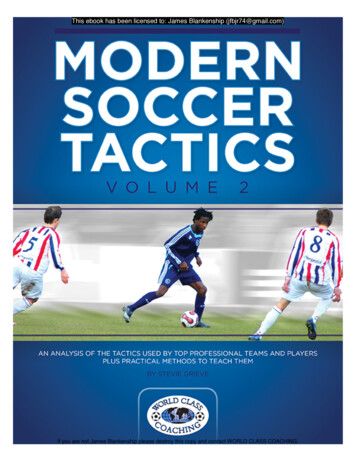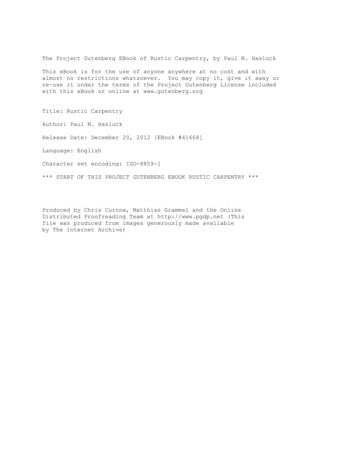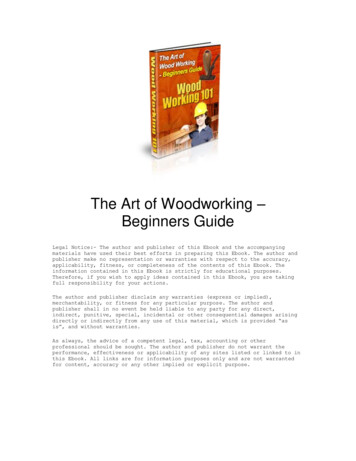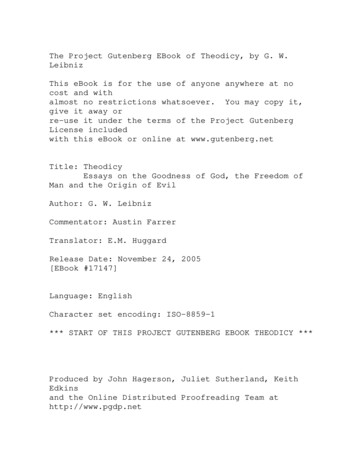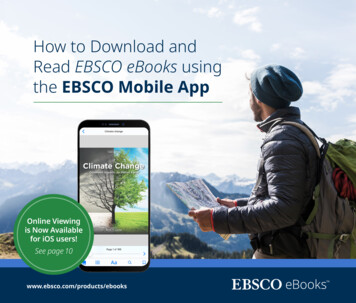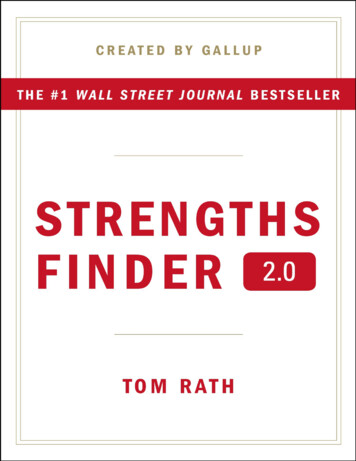
Transcription
This eBook is licensed to Daryl Trembath, daryl@ournet.net.au
GALLUP PRESS1330 Avenue of the Americas17th FloorNew York, NY 10019ISBN: 978-1-59562-024-8Gallup Strengths Center version July 2015Copyright 2007, 2015 Gallup, Inc.All rights reserved, including the right of reproduction in whole or in part in any form.Gallup , Clifton StrengthsFinder , Gallup Press , Q12 , StrengthsFinder , and the 34Clifton StrengthsFinder theme names are trademarks of Gallup, Inc. All other trademarksare property of their respective owners.The Q12 items are Gallup proprietary information and are protected by law. You may notadminister a survey with the Q12 items or reproduce them without written consent fromGallup. Copyright 1993-1998 Gallup, Inc. All rights reserved.This eBook is licensed to Daryl Trembath, daryl@ournet.net.au
Table of ContentsDonald O. CliftonIMPORTANT Information About Taking Clifton StrengthsFinderStrengthsFinder: The Next GenerationPART I: Finding Your Strengths — An IntroductionPART II: Applying Your StrengthsThe 34 Themes and Ideas for ne
eSignificanceStrategicWooVFAQ (VERY Frequently Asked Question)This eBook is licensed to Daryl Trembath, daryl@ournet.net.au
Donald O. Clifton1924-2003Inventor of the Clifton StrengthsFinder and recognized as the Father of StrengthsBased Psychology by an American Psychological Association PresidentialCommendationThis eBook is licensed to Daryl Trembath, daryl@ournet.net.au
IMPORTANT Information About TakingClifton StrengthsFinderYour ebook retailer will provide you with your unique, one-use-only access totake the Clifton StrengthsFinder assessment that is included with this book. Totake the assessment, visit www.gallupstrengthscenter.com.This eBook is licensed to Daryl Trembath, daryl@ournet.net.au
StrengthsFinder:The Next GenerationIn 1998, I began working with a team of Gallup scientists led by the late Fatherof Strengths Psychology, Donald O. Clifton. Our goal was to start a globalconversation about what’s right with people.We were tired of living in a world that revolved around fixing ourweaknesses. Society’s relentless focus on people’s shortcomings had turnedinto a global obsession. What’s more, we had discovered that people haveseveral times more potential for growth when they invest energy in developingtheir strengths instead of correcting their deficiencies.Based on Gallup’s 40-year study of human strengths, we created alanguage of the 34 most common talents and developed the CliftonStrengthsFinder assessment to help people discover and describe these talents.Then in 2001, we included the initial version of this assessment with thebestselling management book Now, Discover Your Strengths. The discussionquickly moved beyond the management audience of this book. It appears thatthe world was ready to have this conversation.Over the past few years alone, millions of people have participated inStrengthsFinder and learned about their top five themes of talent — and Now,Discover Your Strengths has spent more than five years on the bestseller lists.The assessment has since been translated into more than 20 languages and isused by businesses, schools, and community groups in more than 100 nationsaround the world. Yet when it comes to creating strength-based families,communities, and workplaces, we still have a lot of work to do.
Over the past decade, Gallup has surveyed more than 10 million peopleworldwide on the topic of employee engagement (or how positive andproductive people are at work), and only one-third “strongly agree” with thestatement:“At work, I have the opportunity to do what I do best every day.”And for those who do not get to focus on what they do best — theirstrengths — the costs are staggering. In a recent poll of more than 1,000people, among those who “strongly disagreed” or “disagreed” with this “whatI do best” statement, not one single person was emotionally engaged on thejob.In stark contrast, our studies indicate that people who do have theopportunity to focus on their strengths every day are six times as likely to beengaged in their jobs and more than three times as likely to report having anexcellent quality of life in general.Fortunately, our research also suggests that having someone at work whoregularly focuses on your strengths can make a dramatic difference. In 2005,we explored what happens when managers primarily focus on employees’strengths, primarily focus on employees’ weaknesses, or ignore employees.What we found completely redefined my perspective about how easy it may beto decrease the active disengagement, or extreme negativity, that runs rampantin organizations.If your managerprimarily:The chances of your being activelydisengaged are:Ignores you40%Focuses on yourweaknesses22%
Focuses on yourstrengths1%As you can see from these results, having a manager who ignores you iseven more detrimental than having a manager who primarily focuses on yourweaknesses. Perhaps most surprising is the degree to which having a managerwho focuses on your strengths decreases the odds of your being miserable onthe job. It appears that the epidemic of active disengagement we see inworkplaces every day could be a curable disease . . . if we can help the peoplearound us develop their strengths.What’s New in StrengthsFinder 2.0?Our research and knowledge base on the topic of human strengths haveexpanded dramatically over the past decade. StrengthsFinder 2.0 picks upwhere the first version left off, and it is designed to provide you with the latestdiscoveries and strategies for application. The language of 34 themes remainsthe same, but the assessment is faster and even more reliable. And, the resultsyield a much more in-depth analysis of your strengths.Once you have completed the online assessment, you will have access topersonalized reports and tools, including the comprehensive Strengths Insightand Action-Planning Guide that is based on your StrengthsFinder 2.0 results.This guide features an in-depth dive into the nuances of what makes youunique, using more than 5,000 new personalized Strengths Insights that wehave discovered in recent years.Going far beyond StrengthsFinder 1.0’s shared theme descriptions, whichcan be found in Part II of this book, these highly customized Strengths Insightswill help you understand how each of your top five themes plays out in your
life on a much more personal level. For example, even though you and a friendmay both have the same theme in your top five, the way this theme ismanifested will not be the same. Therefore, each of you would receive entirelydifferent, personalized descriptions of how that theme operates in your lives.These new Strengths Insights describe what makes you stand out whencompared to the millions of people we have studied.The guide also includes 10 “Ideas for Action” for each of your top fivethemes. So, you will have 50 specific actions you can take — ideas we culledfrom thousands of best-practice suggestions — that are customized to your topfive themes. In addition, the guide will help you build a strengths-baseddevelopment plan by exploring how your greatest natural talents interact withyour skills, knowledge, and experience. And the new website includes severalother resources you can use to learn more about your strengths and the strengthsof others.While learning about your strengths may be an interesting experience, itoffers little benefit in isolation. This new book, assessment, website, anddevelopment guide are all about application. If you want to improve your lifeand the lives of those around you, you must take action. Use the personalizeddevelopment guide to align your job and goals with your natural talents. Sharethis plan with your coworkers, boss, or closest friends. Then help the peoplearound you — at work and at home — develop their strengths. If you do,chances are you will find yourself in a much more positive and productiveenvironment.This eBook is licensed to Daryl Trembath, daryl@ournet.net.au
PART I:Finding Your Strengths — An IntroductionThis eBook is licensed to Daryl Trembath, daryl@ournet.net.au
The Path of Most ResistanceAt its fundamentally flawed core, the aim of almost any learning program is tohelp us become who we are not. If you don’t have natural talent with numbers,you’re still forced to spend time in that area to attain a degree. If you’re notvery empathic, you get sent to a course designed to infuse empathy into yourpersonality. From the cradle to the cubicle, we devote more time to ourshortcomings than to our strengths.This is quite apparent in the way we create icons out of people whostruggle to overcome a lack of natural talent. Consider the true story of RudyRuettiger, the 23-year-old groundskeeper at Notre Dame’s stadium, who wasthe protagonist of the 1993 movie Rudy. At just 5'6" and 165 pounds, thisyoung man clearly didn’t possess the physical ability to play big-time collegefootball, but he had ample “heart.”Rudy worked tirelessly to gain admission to Notre Dame so he could playfootball there. Eventually, after being rejected three times, he was accepted atNotre Dame and soon thereafter earned a spot on the football team’s practicesquad.For two years, Rudy took a beating in daily practices, but he was neverallowed to join his team on the sidelines. Then, after trying as hard as he couldfor two seasons, Rudy was finally invited to suit up for the final game of hissenior year. In the last moments of this game, with a Notre Dame victory safelyin hand, Rudy’s teammates lobbied their coach to put him in the game. In thefinal seconds, the coach sent Rudy in for a single play — and he tackled theopposing team’s quarterback.It was a dramatic moment and, of course, Rudy became an instant hero.
Fans chanted his name and carried him off the field. Ruettiger was later invitedto the White House, where he met President Bill Clinton, Colin Powell, andfootball legend Joe Montana. While Rudy’s perseverance is admirable, in theend, he played a few seconds of college football and made a single tackle . . .after thousands of hours of practicing.The inspirational nature of this story actually masks a significant problem:Overcoming deficits is an essential part of the fabric of our culture. Our books,movies, and folklore are filled with stories of the underdog who beats one-ina-million odds. And this leads us to celebrate those who triumph over theirlack of natural ability even more than we recognize those who capitalize ontheir innate talents. As a result, millions of people see these heroes as beingthe epitome of the American Dream and set their sights on conquering majorchallenges. Unfortunately, this is taking the path of most resistance.A Misguided Maxim?“You can be anything you want to be, if you just try hard enough.”Like most people, I embraced this maxim at a young age. Along withthousands of other kids, I spent a good chunk of my childhood trying to be thenext Michael Jordan. Every day, I practiced shooting hoops for three to fourhours. I went to basketball camps each summer and tried in every way possibleto be a great player. No matter how hard I worked at it, though, becoming anNBA star simply wasn’t in the cards for me. After giving 100% of my effort formore than five years, I couldn’t even make the junior varsity team.Embracing the “You-can-be-anything-you-want-to-be” maxim isn’tsomething we outgrow. Similar scenarios play out in the workplace every day.A star salesperson thinks she can be a great sales manager with enough effort.She interviews other managers to gain insight, reads every book on
management she can find, and stays late every night trying to get the job done— at the expense of her family and even her health. Then, a few years into thejob, she realizes that she doesn’t have the natural talent to develop otherpeople. Not only is this a waste of her time, but chances are, she could haveincreased her contribution even more if she had stayed in the sales role — arole in which she naturally excelled. Yet if we want additional income, status,or responsibility, most organizational hierarchies force us into a very differentrole — instead of allowing for an entire career of progression within aspecific role that fits our talents.What’s even more disheartening is the way our fixation on deficits affectsyoung people in the home and classroom. In every culture we have studied, theoverwhelming majority of parents (77% in the United States) think that astudent’s lowest grades deserve the most time and attention. Parents andteachers reward excellence with apathy instead of investing more time in theareas where a child has the most potential for greatness.The reality is that a person who has always struggled with numbers isunlikely to be a great accountant or statistician. And the person without muchnatural empathy will never be able to comfort an agitated customer in the warmand sincere way that the great empathizers can. Even the legendary MichaelJordan, who embodied the power of raw talent on a basketball court, could notbecome, well, the “Michael Jordan” of golf or baseball, no matter how hard hetried.This might sound like a heretical point of view, especially for those of uswho grew up believing the essential American myth that we could becomeanything we wanted. Yet it’s clear from Gallup’s research that each person hasgreater potential for success in specific areas, and the key to humandevelopment is building on who you already are.
The following real-life example from Gallup’s economic developmentwork in Puebla, Mexico, provides a basic yet powerful illustration of what canhappen when people focus on their natural talents.Hector had always been known as a great shoemaker. In fact, customersfrom such far-off places as France claimed that Hector made the best shoes inthe world. Yet for years, he had been frustrated with his small shoemakingbusiness. Although Hector knew he was capable of making hundreds of shoesper week, he was averaging just 30 pairs. When a friend asked him why,Hector explained that while he was great at producing shoes, he was a poorsalesman — and terrible when it came to collecting payments. Yet he spentmost of his time working in these areas of weakness.So, Hector’s friend introduced him to Sergio, a natural salesman andmarketer. Just as Hector was known for his craftsmanship, Sergio could closedeals and sell. Given the way their strengths complemented one another,Hector and Sergio decided to work together. A year later, this strengths-basedduo was producing, selling, and collecting payment for more than 100 pairs ofshoes per week — a more than threefold increase.While this story may seem simplistic, in many cases, aligning yourselfwith the right task can be this easy. When we’re able to put most of our energyinto developing our natural talents, extraordinary room for growth exists. So, arevision to the “You-can-be-anything-you-want-to-be” maxim might be moreaccurate:You cannot be anything you want to be — but you can be a lot more ofwho you already are.The Strengths Zone
Over the past few decades, Gallup has studied how talent can be applied in awide variety of roles, from housekeepers to chief executives and from clergymembers to government officials. We’ve researched almost every majorculture, country, industry, and position. The good news is that we have foundgreat examples of heroes who are soaring with their strengths in every singlerole. Across the board, having the opportunity to develop our strengths is moreimportant to our success than our role, our title, or even our pay. In thisincreasingly talent-driven society, we need to know and develop our strengthsto figure out where we fit in.That being said, across all areas we have studied, the vast majority ofpeople don’t have the opportunity to focus on what they do best. We havesurveyed more than 10 million people on this specific topic, andapproximately 7 million are falling short.What happens when you’re not in the “strengths zone”? You’re quitesimply a very different person. In the workplace, you are six times less likelyto be engaged in your job. When you’re not able to use your strengths at work,chances are that you:dread going to workhave more negative than positive interactions with your colleaguestreat your customers poorlytell your friends what a miserable company you work forachieve less on a daily basishave fewer positive and creative momentsBeyond the world of work, there are even more serious implications foryour health and relationships if you’re not in the strengths zone. And Gallup’sresearch has shown how a strengths-based approach improves your
confidence, direction, hope, and kindness toward others.So why isn’t everyone living life with a strengths approach? One bigproblem is that most people are either unaware of, or unable to describe, theirown strengths . . . or the strengths of the people around them.Your Themes of Talent“Most people think they know what they are good at. They are usuallywrong. . . . And yet, a person can perform only from strength.”— Business guru Peter Drucker (1909-2005)In the mid 1960s, my late mentor and the Father of Strengths Psychology,Don Clifton, realized that we already had countless “languages” for describingwhat’s wrong with people. In addition to the informal labels used by thepeople around us, the field of psychology has the DSM-IV, a manual ofdisorders described by one leading psychologist as “a bloated catalogue ofwhat’s wrong with people.” The world of business has myriad competencymodels, most of which are oriented toward describing what isn’t working(even though these labels are often veiled as “areas for improvement”).To initiate more conversation about what’s right with people, in 1998,Clifton assembled a team of scientists and set forth the ambitious goal ofdeveloping a common language for talent. This team wanted individuals andorganizations to have very specific terms for describing what people do well.So we mined our database, which at the time contained more than 100,000talent-based interviews, and looked for patterns in the data. We examinedspecific questions that had been used in our studies of successful executives,salespeople, customer service representatives, teachers, doctors, lawyers,students, nurses, and several other professions and fields. Through this
process, we were able to identify 34 themes of talent that were the mostcommon in our database. We then developed the first version of the CliftonStrengthsFinder assessment to measure these distinct talents.These 34 themes represent our best attempt at creating a common languageor classification of talents. By no means did we capture everything. There arehundreds of even more specific themes we did not include in thisclassification. However, we wanted to keep this language manageable so itwould be easy to use with work teams, families, and friends.What StrengthsFinder actually measures is talent, not strength. As anaside, we named it “StrengthsFinder” instead of “TalentFinder” because theultimate goal is to build a true strength, and talent is just one of the ingredientsin this formula. The assessment doesn’t ask about your knowledge — there areno questions about your formal education, degrees, or résumé. Nor does it askabout your skills — whether you’re able to perform the fundamental steps ofdriving a car, using a particular software package, or selling a specificproduct. While these are important, we have discovered that knowledge andskills — along with regular practice — are most helpful when they serve asamplifiers for your natural talents.When you take the assessment, you have just 20 seconds to respond toeach item. It’s quick because we found that instinctual, top-of-mind responsesare more revealing than those you’d give if you sat around and debated eachquestion. Essentially, the instrument is attempting to identify your most intensenatural responses, which are less likely to change over time.A Recipe for StrengthAlthough people certainly do change over time and our personalities adapt,scientists have discovered that core personality traits are relatively stable
throughout adulthood, as are our passions and interests. And more recentresearch suggests that the roots of our personality might be visible at an evenyounger age than was originally thought. A compelling 23-year longitudinalstudy of 1,000 children in New Zealand revealed that a child’s observedpersonality at age 3 shows remarkable similarity to his or her reportedpersonality traits at age 26.1 This is one of the reasons why StrengthsFindermeasures the elements of your personality that are less likely to change — yourtalents.Knowledge, skills, and practice are also important parts of the strengthsequation. Without basic facts in your mind and skills at your disposal, talentcan go untapped. Fortunately, it’s also easier to add knowledge and skills toyour repertoire. You can always take a course on understanding basicfinancials, just as you can always learn how to use a new software application.Building your talents into real strengths also requires practice and hard work,much like it does to build physical strengths. For example, if you are born withthe potential to build large biceps, but you do not exercise these musclesregularly, they will not develop. However, if you do work equally as hard assomeone without as much natural potential, you are likely to see much greaterreturn.But adding raw talent is a very different story. While it may be possible,with a considerable amount of work, to add talent where little exists, ourresearch suggests that this may not be the best use of your time. Instead, we’vediscovered that the most successful people start with dominant talent — andthen add skills, knowledge, and practice to the mix. When they do this, the rawtalent actually serves as a multiplier.
This brings us back to Rudy Ruettiger, a classic example of hard workoffsetting a lack of natural talent to reach a basic level of competence. WhileRudy might have scored a perfect 5 on a 1-5 scale for investment (the time hespent practicing and building his knowledge and skills), let’s assume he was a2 on the talent scale. So his maximum potential for building strength in thisarea was only 10 (5 x 2), even when he scored as high as possible on theinvestment scale. And it is likely that Rudy had teammates for whom theinverse was true — they were a 5 on talent and just a 2 on time invested,which is clearly a waste of talent. And once in a while, you see a player likeformer Notre Dame great Joe Montana, who had abundant natural talentcombined with hard work and the right developmental opportunities. Thiscombination of a 5 in both areas — which yields a total score of 25, comparedto Rudy’s score of 10 — is what can elevate someone to an entirely differentlevel.Even though we recognize that everyone is different, all too often, we giveonly surface attention to this crucial insight. It is relatively easy to describe ouracquired expertise, but most of us struggle when asked to describe our naturaltalents. If you find it difficult to name all of your talents, take a step back, and
you’ll see that talents often have something in common — a theme — thatconnects them. Some talents — like natural tendencies to share thoughts, tocreate engaging stories, and to find the perfect word — are directly connectedto communication. That’s what they have in common — their theme. So tobegin thinking and talking about them, we can call them Communication talents.Other talents — such as natural dependability, sense of commitment, andavoidance of excuses — have a responsibility theme, so we identify them asResponsibility talents. This theme language gives us a starting place fordiscovering our talents and learning even more about our potential for strength.Managing WeaknessesIn any occupation or role, it’s helpful to know your areas of lesser talent.That’s especially true if the demands of your job pull you in that direction, asyour lesser talents can lead to weakness. As you study the descriptions of the34 themes, see if you can identify a few areas in which you are clearly lackingin talent and have little potential to create a strength. In many cases, simplybeing aware of your areas of lesser talent can help you avoid majorroadblocks.Once you’re able to acknowledge, for example, that you are not great atmanaging details, it opens several doors for working around that lesser talent.The first question to ask yourself is whether it’s necessary for you to operate inyour area of lesser talent at all. If it’s possible for you to simply avoid doingdetail-oriented work, by all means, move away from this area. Of course, mostof us don’t have the luxury to simply stop doing necessary tasks just becausewe aren’t naturally good at them. When you must attend to details, you mightneed to establish systems to manage your lesser talent and keep things on track.If maintaining your daily schedule is a detail you dread, there are severaloptions, ranging from a day planner to an electronic calendar.
Another strategy is to partner with someone who has more talent in theareas in which you are lacking. For example, the Includer theme is an area oflesser talent for me. People who have this talent are great at making sure thateveryone feels involved and part of any team effort. On the contrary, I will rushto assemble a group without considering everyone involved, and in manycases, this results in people feeling left out. So I have learned to partner withmy colleague, Amanda, who leads with her Includer. She helps me think aboutincluding people I would not have otherwise considered. In several cases, thishas helped us uncover people’s hidden talents and build a stronger team.Blind SpotsIt is also essential to try to become more conscious of any “blind spots” thatare caused by your talents. For example, those of us with strong Command maynot realize the damage left in our wake as we are pushing to get things doneeach day. Or people with dominant Consistency talents might focus so much onkeeping the steps uniform that they ignore the overall outcome or goal.So while our talents primarily serve to keep us on track, they can at timesderail our pursuits. In Part II, you will find 10 Ideas for Action for each of the34 themes. Many of these action items will help you when you are on thelookout for blind spots that can result from your dominant talents. The key isfor you to be aware of your potential and your limitations.The New Assessment, Website, and DevelopmentGuideAnalyzing millions of StrengthsFinder interviews has allowed us to refine theassessment into an even faster and more precise second version. We’ve alsobeen working to glean more advanced insights from the hundreds of items we
collect as you take the assessment.Even though the 34 themes help us describe a great deal of the variation inhuman talent, they do not capture many nuances of unique personalities. Whileyou and a few friends may each have Learner among your top five themes, thefine points of those talents and how they are expressed vary a great deal fromperson to person: One of you may learn from reading several books eachmonth, while someone else learns primarily from doing, and yet another learnsfrom an insatiable curiosity and Googles everything.To help you think about your own talents at a more specific andindividualized level, we have added more than 5,000 Strengths Insights inStrengthsFinder 2.0. Based on unique combinations of your individual itemresponses during the assessment, these insights will give you an in-depthanalysis of how each of your top five themes plays out in your life. Unlike theshared theme descriptions from StrengthsFinder 1.0, which are the same foreveryone, the descriptions in your StrengthsFinder 2.0 report will becustomized to describe your personality.To create these highly tailored theme descriptions, we compare all of yourresponses on these 5,000-plus Strengths Insights to our massive database andthen build your theme descriptions based on what makes you stand out themost. Unlike your top five themes of talent, which are likely to overlap withpeople you know and serve an important purpose in providing a commonlanguage, the Strengths Insights are all about what makes you unique.Once you have completed the StrengthsFinder 2.0 assessment, you willhave access to a comprehensive Strengths Insight and Action-Planning Guidethat includes:Your top five theme report, built around the new Strengths Insight
descriptions50 Ideas for Action (10 for each of your top five themes) based onthousands of best-practice suggestions we reviewedQuestions for you to answer to increase your awareness of your talentsand how to apply themYou also will find these resources on the website:A tool for customizing your strengths-based action planA tool for creating customized display cards of your top five themesA quick reference guide with descriptions of all 34 CliftonStrengthsFinder themesA team strengths grid for mapping the talents of those around youDevelopment guides for each of your top five themesVideos for each of your top five themes, demonstrating what each themelooks like in actionInformative videos for developing your talents into strengthsParting ThoughtsOur natural talents and passions — the things we truly love to do — last for alifetime. But all too often, our talents go untapped. Mark Twain once describeda man who died and met Saint Peter at the Pearly Gates. Knowing that SaintPeter was very wise, the man asked a question that he had wondered aboutthroughout his life.He sai
Clifton StrengthsFinder Your ebook retailer will provide you with your unique, one-use-only access to take the Clifton StrengthsFinder assessment that is included with this book. To take the assessment, visit www.gallupstrengthscenter.com. This eBook is licensed to Daryl Trembath, daryl@ournet.net.au
